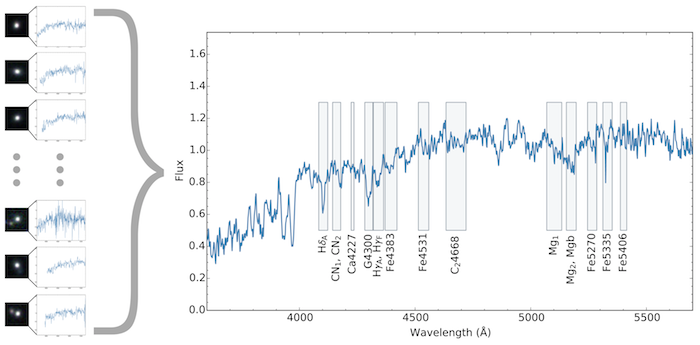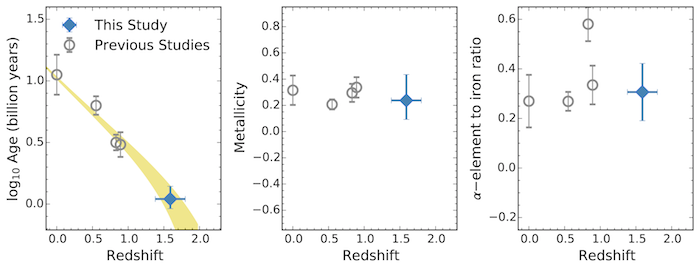.
![]()
An international team led by researchers at Swiss Federal Institute of Technology in Zürich observed massive dead galaxies in the universe 4 billion years after the Big Bang with the Subaru Telescope's Multi-Object InfraRed Camera and Spectrograph (MOIRCS). They discovered that the stellar content of these galaxies is strikingly similar to that of massive elliptical galaxies seen locally. Furthermore, they identified progenitors of these dead galaxies when they were forming stars at an earlier cosmic epoch, unveiling the formation and evolution of massive galaxies across 11 billion years of cosmic time.
In the local universe, massive galaxies hosting more than about 100 billion stars are predominantly dead elliptical galaxies, that is, without any signs of star-formation activity. Many questions remain on when, how and for how long star formation occurred in such galaxies before the cessation of star formation, as well as what happened since to form the dead elliptical galaxies seen today.
In order to address these issues, the research team made use of fossil records imprinted by stars in the spectra of distant dead galaxies which give important clues to their age, metal content, and element abundances. Local massive dead galaxies are about 10 billion years old and rich in heavy elements. Also, α-elements (Note 1), which measure the duration of star formation, are more abundant than iron, indicating that these galaxies formed a large amount of stars in a very short period. The team investigated the stellar content of galaxies in the distant universe 4 billion years after the Big Bang, in order to study galaxy evolution much closer to their formation epoch.
The team took the advantage of the MOIRCS's capability to observe multiple objects simultaneously, efficiently observing a sample of 24 faint galaxies. They created a composite spectrum that would have taken 200 hours of Subaru Telescope's time for a single spectrum of comparable quality (Figure 1).
.

Figure 1: Composite spectrum of 24 massive dead galaxies in the universe 4 billion years after the Big Bang. The spectra is equivalent to 200 hours of Subaru Telescope's observing time. Rectangles on the spectrum indicate spectral features, which are used to calculate the ages, the amount of heavy elements and the α-element abundance in the stellar populations of these galaxies. (Credit: ETH Zürich/NAOJ)
-
Analysis of the composite spectrum shows that the age of the galaxies is already 1 billion years old when observed 4 billion years after the Big Bang. They host 1.7 times more heavy elements relative to the amount of hydrogen and their α-elements are twice enhanced relative to iron than the solar values. It is the first time that the α-element abundance in stars is measured in such distant dead galaxies, and it tells us that the duration of star formation in these galaxies was shorter than 1 billion years. These results reveal that these massive dead galaxies have evolved to today without further star formation (Figure 2).
.

Figure 2: Cosmic evolution of the age (Left), the abundance of heavy elements (Middle) and the abundance of α-elements relative to iron (Right) of massive dead elliptical galaxies. Gray data points show the results from previous works by other studies. The colored strip in the left panel is a prediction of their evolution if such massive elliptical galaxies formed 10 to 11 billion years ago (redshift of about 2.3) and evolved without forming new stars to the present universe (redshift of zero). The prediction agrees with the observed trend very well. The middle and left panels clearly show that chemical composition of massive elliptical galaxies does not evolve over cosmic time. (Credit: ETH Zürich/NAOJ)
Quelle: Subaru Telescope / NAOJ
4542 Views
